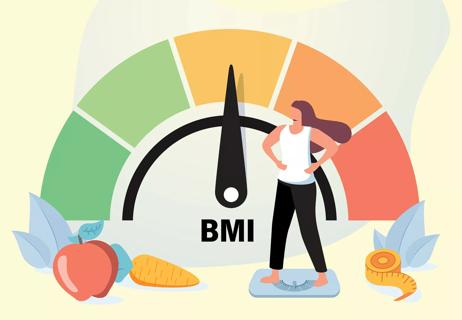From your ideal BMI to when to take it with a grain of salt

You may have seen those handy online body mass index (BMI) calculators. Maybe you even punched in your weight and height to get your results. And maybe you were shocked by what you saw and vowed never to use one again. You’re not alone.
Advertisement
Cleveland Clinic is a non-profit academic medical center. Advertising on our site helps support our mission. We do not endorse non-Cleveland Clinic products or services. Policy
Physiologist Chris Dempers, ACSM EP-C, and fitness specialist Colt Mcdonough explain the pros and cons of using BMI charts to measure health.
BMI is typically measured as weight in kilograms divided by height in meters squared. The resulting number is supposed to show if your weight is within the underweight, healthy weight, overweight or obesity range.
Doctors typically use BMI as a window into your overall health. But when it comes to BMI for women, the view gets a little foggy.
“BMI is useful because it’s a quick, convenient health assessment for the general population. But it’s one-size-fits-all,” says Dempers. “And there are key differences across sexes that could affect its reliability as an indicator of health. For example, women typically have more body fat than men but there isn’t a separate BMI chart for women.”
To calculate your BMI, use this adult BMI calculator.
You can also use these formulas to calculate your BMI:
A healthy BMI for women falls between 18.5 and 24.9. Find your BMI in the chart below to see your weight classification.
Advertisement
| BMI | Weight classification |
|---|---|
| Below 18.5 | Underweight |
| 18.5-24.9 | Normal |
| 25.0-29.9 | Overweight |
| 30.0 or higher | Obesity |
| BMI | |
| Below 18.5 | |
| Weight classification | |
| Underweight | |
| 18.5-24.9 | |
| Weight classification | |
| Normal | |
| 25.0-29.9 | |
| Weight classification | |
| Overweight | |
| 30.0 or higher | |
| Weight classification | |
| Obesity |
If you’re pregnant or plan on becoming pregnant, you can calculate your recommended weight gain using your pre-pregnancy BMI.
| BMI before pregnancy | Recommended pregnancy weight gain |
|---|---|
| Below 18.5 | 28 to 40 pounds |
| 18.5-24.9 | 25 to 35 pounds |
| 25.0-29.9 | 15 to 25 pounds |
| 30.0 or higher | 11 to 20 pounds |
| BMI before pregnancy | |
| Below 18.5 | |
| Recommended pregnancy weight gain | |
| 28 to 40 pounds | |
| 18.5-24.9 | |
| Recommended pregnancy weight gain | |
| 25 to 35 pounds | |
| 25.0-29.9 | |
| Recommended pregnancy weight gain | |
| 15 to 25 pounds | |
| 30.0 or higher | |
| Recommended pregnancy weight gain | |
| 11 to 20 pounds |
BMI is a controversial tool, with many health experts saying it’s a dinosaur that should be extinct. “BMI was developed 180 years ago, and they were getting most of their data from corpses. Since then, the average height and weight for females and males have also increased,” says Dempers.
Your listed BMI range could also be unreliable if you are:
The more active you are, the more muscle mass you tend to have. “BMI does not factor in body fat or muscle mass, so for athletes, it’s useless,” notes Dempers.
Also, higher density muscles weigh more, says Mcdonough. “So, that skews BMI results. Most athletes are going to be in the overweight to obesity range.”
“The older you are, the more body fat you tend to have,” says Mcdonough. “As you go through menopause, your hormone levels decrease. As hormones decrease, it causes decreases in muscle mass and increases in belly fat.”
Even if you weigh the same at 70 as you did at 30, you may have significantly more body fat. Research has even shown that some women who are postmenopausal with a healthy BMI may actually fall into the range of overweight or obesity.
Ethnicity can affect your body fat distribution and muscle mass. For example, one study found that women of Mexican descent had more body fat than both women who are white and Black. It also found that women who are Black tended to have more muscle mass than women who are white or women of Mexican descent. But BMI does not account for these differences.
“Your ethnicity could throw off your BMI number,” says Mcdonough. “You may have the same BMI as another person, but your health and risk of obesity-related illnesses may be much different.”
Researchers have also learned that different ethnicities, including white, Black, South Asian and Middle Eastern, tend to become at higher risk for developing Type 2 diabetes at different BMI scores.
Dempers and Mcdonough say there are other effective ways to do a temperature check on your health. “Don’t be discouraged if your BMI is high. It’s only part of the picture. Investigate further and talk to your doctor or another professional about other areas of body fat assessment,” adds Mcdonough.
DEXA is a bone density scan that tells you your percentage of bone mass, muscle mass and body fat. “You get a clearer picture of your body composition,” explains Mcdonough.
Advertisement
Many scales today are equipped with body fat scanners. “They have metal plates on them that send a small current through your body to give you a rough estimate of what your body fat percentage is,” says Dempers. “While they typically have a standard deviation of about plus or minus seven on the accuracy scale, they still give you a good ballpark measurement.”
It may seem old-fashioned (or even triggering), but looking at yourself in the mirror can be helpful, says Dempers. “It may be hard for some people, but it’s not about nitpicking yourself. Instead, it can be a valuable tool to see where you’re at and then measure your progress as you achieve your health goals.”
“Your essential body fat percentage is the bare minimum of body fat that you need to stay healthy and have healthy brain function,” explains Dempers.
“Have someone experienced in this method — like an athletic trainer — do a six-site test on your body using calipers, which look like tongs. The test shows what your body fat percentage is and if you have more muscle density than what your BMI indicates,” adds Mcdonough. “The average essential body fat percentage range for females is 25% to 31%.”
Your waist-to-hip ratio is your waist measurement divided by hip measurement in centimeters. It tells you if you have excess weight and how that weight could affect your health. Here’s how WHR relates to your health:
Advertisement
| WHR for women | Health risks for obesity-related conditions |
|---|---|
| 0.8 or lower | Low |
| 0.81 to 0.84 | Moderate |
| 0.85 or higher | High |
| WHR for women | |
| 0.8 or lower | |
| Health risks for obesity-related conditions | |
| Low | |
| 0.81 to 0.84 | |
| Health risks for obesity-related conditions | |
| Moderate | |
| 0.85 or higher | |
| Health risks for obesity-related conditions | |
| High |
Make sure you stand up straight. To find out your waist circumference, place a tape measure around the smallest part of your waist, which is typically above your belly button. Then to figure out your hip circumference, do the same with the largest part of your hips, typically the widest part of your buttocks. Divide your waist circumference by your hip circumference.
“For the most accurate results, enlist an exercise physiologist or trainer at a fitness center with experience taking these kinds of measurements,” says Dempers. “If you had to pick one of these tools, I’d probably go with measuring your body fat percentage. But overall, it’s best to use a combination of measurements, BMI and body fat to get the most accurate results possible.”
After you use these measurements to get an accurate picture of your health, what are the next steps? If the numbers show that you are carrying extra pounds, talk to your doctor or another health professional about safe, effective ways to lose weight. Stay away from crash or fad diets. A realistic diet and exercise plan will help you look and feel your best for the long-term, BMI calculator or no BMI calculator.
Advertisement
Learn more about our editorial process.
Advertisement

Kids’ BMI is measured in relation to others their age and sex — a healthy range is between the 5th and 84th percentile

Plus, 4 factors that can make BMI misleading

When — and when not — to trust BMI calculators

To help manage symptoms, switch to more absorbent period products, make healthy lifestyle changes and explore treatment options

Yes, you can pee with a tampon in; no, they won’t stretch out your vagina or make cramps worse!

Estrogen loss contributes to bone loss, which significantly raises your risk of osteopenia and osteoporosis

The little blue pill might help with physical arousal, but there are better treatments for low libido in women

Start having sex about 72 hours before ovulation, then at least every other day during your fertile window

Attachment theory suggests that your earliest relationships shape connections throughout your life

It isn’t a recognized mental health disorder, but research shows that problematic social media use can negatively affect your mental health, self-esteem and sleep